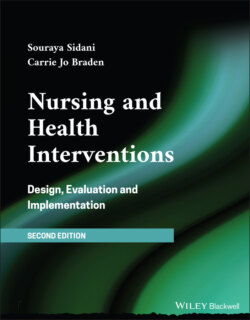Читать книгу Nursing and Health Interventions - Souraya Sidani - Страница 55
3.3 APPROACHES FOR GENERATING THEORY OF THE HEALTH PROBLEM
ОглавлениеDifferent approaches can be utilized, independently or in combination, to gain an understanding of the health problem and generate a theory of the problem. The approaches include theoretical, empirical, and experiential. They reflect different logic and methods of reasoning: deductive (top‐down), inductive (bottom‐up), retroductive (backtracking process of logical inference going beyond an existing theory and empirical observations), and abductive (alternative explanation process). The approaches can be used independently. With the emphasis on evidence‐based practice, the empirical approach was considered the most robust. With the recent emphasis on client engagement in the design of health services and in research, and the widening recognition of the role of context in health and healthcare, the experiential approach has been increasingly advocated. Since each approach has its strengths and limitations, the use of a combination of approaches is recommended (e.g. Aráujo‐Soares et al., 2018; Bartholomew et al., 2016; Bleijenberg et al., 2018) to develop a comprehensive understanding of the health problem as experienced by the target client population in the respective context. The approaches and methods for applying them are discussed next.
TABLE 3.1 Summary of the theory of insomnia.
| Conceptual definition | Nature | Insomnia is conceptualized as a learned behavior Insomnia refers to self‐reported disturbed sleep in the presence of adequate opportunity and circumstances for sleep Insomnia is actually experienced by clients across the life span |
| Operational definition | Defining indicators | Types: Insomnia is manifested in any or a combination of difficulty initiating or maintain sleep Levels: Sleep difficulties reported at ≥30 minutes per night, reported on ≥3 nights per week |
| Severity | Insomnia Severity Index total score: ≤7 = no clinically significant insomnia 8–14 = subthreshold insomnia 15–21 = clinical insomnia of moderate severity 22–28 = clinically severe insomnia | |
| Duration | Acute insomnia: indicators experienced at the specified level, periodically for <3 months Chronic insomnia: indicators experienced at the specified level for ≥3 months | |
| Contributing factors | Determinants | Precipitating factors: onset of illness, stress, life or work‐related events that disrupt sleep |
| Perpetuating factors: cognitions (unrealistic beliefs about sleep, insomnia and its consequences); general behaviors (physical inactivity, smoking); sleep habits or behaviors (irregular sleep schedules, engaging in activities in bed); and engagement in behaviors (extended time in bed) that fuel or maintain insomnia | ||
| Moderators | Predisposing factors: innate characteristics (age, sex, familial or genetic tendency) that increase vulnerability to poor sleep | |
| Environment | Features (light, noise, temperature) in the sleep environment that interfere with good sleep | |
| Consequences | Physical and mental daytime fatigue; reduced engagement in physical and psychosocial functions; home, work, or traffic accidents; development of physical (e.g. hypertension) and psychological (e.g. depression) health conditions |
FIGURE 3.1 Representation of theory of insomnia.
